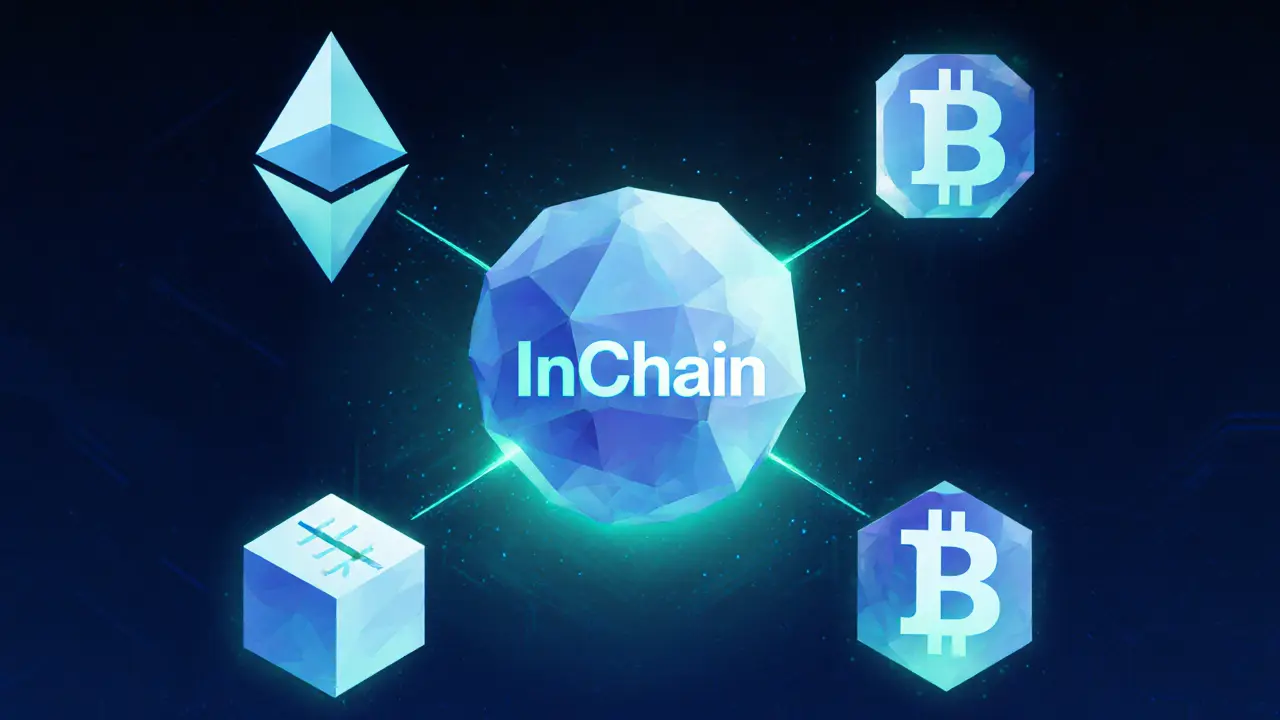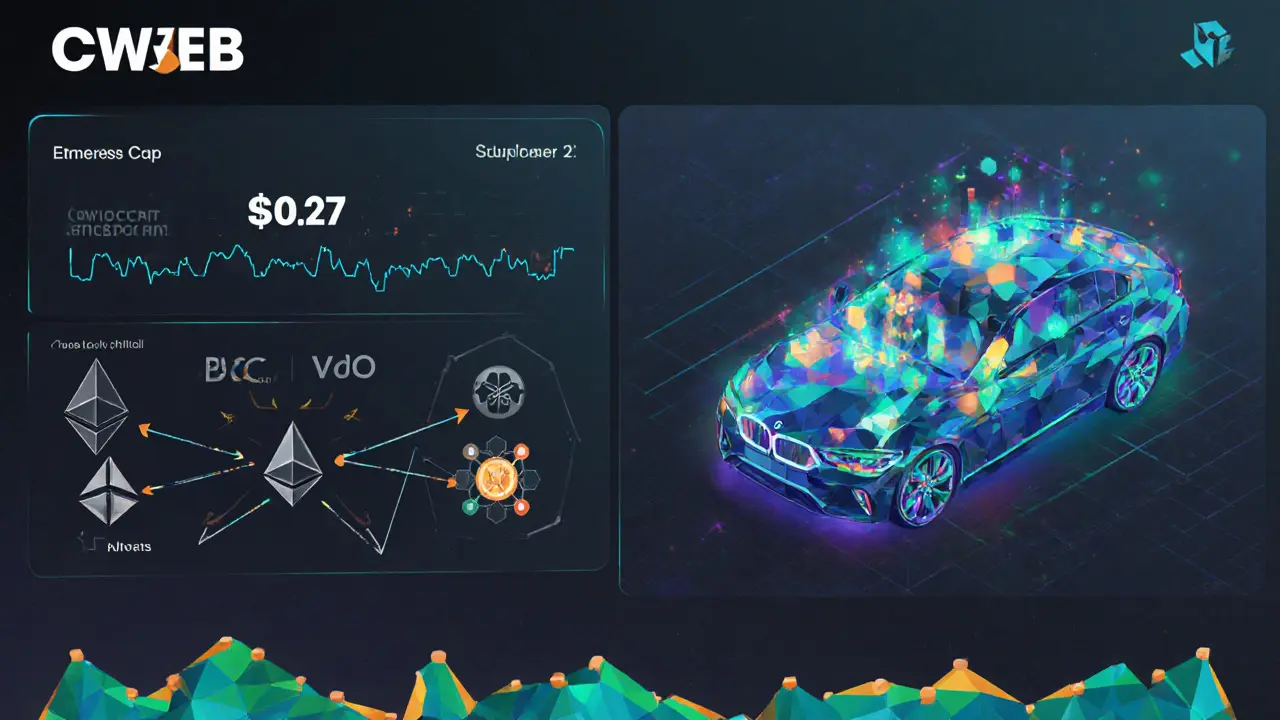Coinweb (CWEB) Explained: What Is This Cross‑Chain Crypto?

Coinweb (CWEB) Token Valuation Calculator
Current Market Data
Price per CWEB: $0.0027
Circulating Supply: 6,292,506,922 CWEB
Market Cap: $17.2M
Fully Diluted Valuation: $21M
Calculator Inputs
Enter your holdings and click Calculate to see your portfolio value.
About Coinweb (CWEB)
Coinweb (CWEB) is a cross-chain computation platform that enables smart contracts to run on multiple blockchains simultaneously through its proprietary InChain architecture. The token serves as the fuel for transactions, staking, and governance within the ecosystem.
With a market cap of $17.2M as of October 2025, CWEB represents a growing piece of the cross-chain interoperability space, offering unique advantages over traditional bridge-based solutions.
TL;DR
- Coinweb (CWEB) is a cross‑chain computation platform that lets dApps run on multiple blockchains at once.
- Its proprietary InChain architecture provides "true" chain abstraction without traditional bridges.
- The CWEB token fuels transactions, staking, and governance within the ecosystem.
- As of Oct12025 the token trades around $0.0027 with a market cap of $17.2M.
- Key use cases include DeFi swaps, tokenisation services, and enterprise pilots such as BMW.
What is Coinweb (CWEB)?
Coinweb is a blockchain‑based cross‑chain computation platform that aims to eliminate the silos between independent networks. It launched its mainnet in December2021 after five years of development that began in 2017. In plain language, Coinweb lets developers write a single smart contract once and have it execute on Ethereum, Bitcoin, Polygon, Binance Smart Chain and dozens of other chains without rebuilding the code for each platform. The native utility token, CWEB, pays for transaction fees, rewards validators, and gives holders a voice in protocol upgrades.
Core Technology: InChain Architecture
The heart of Coinweb is its proprietary InChain architecture. Rather than using a classic bridge that locks assets on one chain and mirrors them on another, InChain creates a **computational layer that lives across multiple ledgers**. This layer records a cryptographic proof of each action, then propagates that proof to every connected blockchain. Because the proof is verified independently on each chain, there is no single point of failure and no need for a consensus mechanism dedicated to cross‑chain messaging.
Smart contracts on Coinweb are compiled to WebAssembly (Wasm) and stored as stateless mathematical functions. Developers can continue using familiar languages (Rust, C++, AssemblyScript) while the Wasm runtime guarantees identical execution results on every linked chain. The horizontal scaling model means that adding a new chain does not slow down existing workloads - the platform simply adds another parallel execution lane.
The CWEB Token: Utility and Economics
CWEB serves three main purposes:
- Transaction fees: Every cross‑chain action incurs a small fee paid in CWEB, which helps offset the cost of indexing and proving data on multiple ledgers.
- Staking & security: Validators stake CWEB to earn the right to bundle actions into a block‑level proof. Honest behavior is rewarded; misbehavior leads to slashing.
- Governance: Token holders vote on protocol upgrades, fee‑structure changes, and the addition of new partner chains.
The circulating supply sits at 6,292,506,922 tokens (≈82% of the 7.68B max). With a current price of $0.0027, the market cap is $17.2M, while the fully‑diluted valuation (FDV) is about $21M. A modest 18% of tokens remain to be released, which leaves room for future fundraising or incentive programs.

How Coinweb Enables True Cross‑Chain Interoperability
Traditional bridge solutions require a trade‑off: they either lock assets on the source chain (introducing custodial risk) or rely on wrapped tokens that may not respect the original chain’s security guarantees. Coinweb’s “strong coupling” approach sidesteps these compromises by:
- Allowing a dApp to call functions on multiple chains in a single transaction.
- Preserving each chain’s native token standards (e.g., ERC‑20, BEP‑20, Bitcoin’s UTXO model) without wrapping.
- Providing a uniform fee model pegged to CWEB, so developers don’t have to calculate separate gas costs for each network.
For example, a DeFi swap that sources liquidity from Ethereum, Binance Smart Chain, and Polygon can be executed atomically: if any leg fails, the entire operation reverts, eliminating partial‑fill risk.
Ecosystem Highlights and Real‑World Partnerships
Coinweb’s ecosystem spans several verticals:
- DeFi: Protocols like Pact Swap and DeconX leverage cross‑chain token issuance to offer better rates.
- Tokenisation: LinkMint creates asset‑backed tokens that can move freely between Bitcoin and Ethereum.
- Payments: The OnRamp wallet integrates CWEB‑based fee payment for fiat‑on‑ramp services.
- Enterprise pilots: A notable partnership with BMW explores using Coinweb’s cross‑chain layer to track supply‑chain data across private and public ledgers.
The platform already connects to major networks such as Bitcoin and Polygon (Layer‑2), giving developers a wide canvas without needing separate deployments.
Market Snapshot (October2025)
As of 1Oct2025, CWEB shows a 24‑hour price range of $0.0026-$0.005 and an annual low‑high band of $0.0026-$0.0094. Daily volume sits around $228K, with a 6% uptick over the previous day. The token trades on MEXC, Gate.io and a handful of regional exchanges; the CWEB/USDT pair on MEXC regularly moves $0.0028‑$0.0030 with a $64K order book.
Despite a -5.25% daily price move and a -24% 30‑day market‑cap change, the low dominance (0.00041% of total crypto market) suggests ample headroom if adoption accelerates.
Coinweb vs. Other Interoperability Solutions
| Feature | Coinweb (CWEB) | Polkadot | Cosmos | Chainlink CCIP |
|---|---|---|---|---|
| Architecture | InChain computational layer (consensus‑free) | Relay chain + parachains (NPoS) | Hub‑and‑spoke zones (Tendermint) | Oracle‑driven messaging layer |
| Bridge model | Strong coupling, no asset wrapping | Cross‑consensus relay, wrapped assets | IBC token transfer (wrapped optional) | Off‑chain proof aggregation |
| Smart‑contract language | WebAssembly (Rust, C++, AssemblyScript) | Ink! (Rust) & Solidity (via Moonbeam) | CosmWasm (Rust) | Solidity (via adapters) |
| Native token | CWEB | DOT | ATOM | LINK (used for fees) |
| Launch year | 2021 (mainnet) | 2020 | 2019 | 2023 (CCIP beta) |
| Key advantage | True chain abstraction, low‑fee unified execution | High security via shared relay | Fast IBC transfers, modular zones | Broad oracle network, easy integration |
The table shows that Coinweb’s main edge is its ability to run a single Wasm contract across chains without wrapping assets. This can lower development overhead and reduce exposure to bridge hacks-a common pain point for DeFi projects.
Pros, Cons, and What to Watch
Pros
- True cross‑chain execution removes the need for multiple deployments.
- Consensus‑free design lowers latency and transaction costs.
- Open‑source code encourages community audits and extensions.
- Enterprise interest (e.g., BMW) validates real‑world relevance.
Cons
- Relatively low market cap means liquidity spikes can cause price slippage.
- Adoption is still early; most dApps are experimental.
- Performance metrics (TPS) are not publicly benchmarked against giants like Ethereum.
Keep an eye on three signals: (1) new chain integrations beyond Bitcoin/Polygon, (2) developer activity on GitHub (pull‑request volume), and (3) any regulatory news affecting cross‑chain token flows.

Frequently Asked Questions
What problem does Coinweb solve?
It removes the silo‑effect of separate blockchains by providing a single computational layer that can run the same smart contract on many networks simultaneously, cutting down development cost and reducing bridge‑related risk.
How are transaction fees paid?
All cross‑chain actions require a small fee in CWEB. The fee covers proof generation, indexing, and validator rewards.
Can I use Coinweb without writing Wasm code?
Yes. Several low‑code SDKs let you compose cross‑chain workflows in JavaScript or Python, which the platform then compiles to Wasm behind the scenes.
Is CWEB a good investment?
Investment risk depends on adoption. If more dApps migrate to Coinweb and enterprise pilots expand, demand for CWEB could rise. As with any crypto, weigh volatility, liquidity and your own risk tolerance.
Where can I buy CWEB?
The token is listed on MEXC, Gate.io and a few regional exchanges. Always use reputable platforms and consider transferring to a non‑custodial wallet that supports Coinweb’s network.

Rajini N
December 24, 2024 AT 18:32Coinweb's InChain idea is neat. It could simplify dev work across chains, but keep an eye on token liquidity.
Kate Roberge
December 28, 2024 AT 16:59Honestly, the hype around CWEB feels overblown. The market cap is tiny and price volatility is insane. Most projects will never move beyond the lab.
Oreoluwa Towoju
January 1, 2025 AT 15:25Cross‑chain execution sounds promising, but the real test is developer adoption. Let's watch the GitHub commits.
Jason Brittin
January 5, 2025 AT 13:52Wow, another platform promising 'true' cross‑chain magic 🙄🚀. If they can actually pull it off, I'll be impressed.
Amie Wilensky
January 9, 2025 AT 12:19Sure, the whitepaper is glossy, the demo videos are slick, the token economics look tidy, yet the underlying risk remains, and that's the crux.
VICKIE MALBRUE
January 13, 2025 AT 10:45Stay positive, folks!
april harper
January 17, 2025 AT 09:12The promise of a single contract dancing across Bitcoin, Ethereum, and Polygon is almost poetic. Yet I can't help but feel the market will swallow the dream before it breathes. Expect volatility. Time will tell.
Waynne Kilian
January 21, 2025 AT 07:39i think the idea is cool but we need more data about teh actual throughput. also the partnership with BMW sounds fancy.
Kate Nicholls
January 25, 2025 AT 06:05The token's price range is a rollercoaster; liquidity is thin. Until real users deploy, it's just speculation.
Jacob Anderson
January 29, 2025 AT 04:32Oh great, another low‑cap token to lose your shirt on. Just what the world needed.
Ben Dwyer
February 2, 2025 AT 02:59While the price swing is sharp, consider that early-stage tech often sees big moves. If the ecosystem matures, the token could gain stability.
Katrinka Scribner
February 6, 2025 AT 01:25Honestly, I'm excited but also scared 😅. Those fees could eat profits quickly!
Billy Krzemien
February 9, 2025 AT 23:52Good point about dev adoption. I’ve seen a few repos start adding Coinweb SDKs; that’s a promising signal.
Clint Barnett
February 13, 2025 AT 22:19Coinweb’s InChain architecture is attempting to rewrite the playbook of blockchain interoperability in a way that most of us have only dreamed about.
By abstracting the execution layer into a consensus‑free computational stratum, it promises to eliminate the latency and security trade‑offs that have plagued traditional bridges for years.
From a developer’s standpoint, the ability to author a single Wasm contract and see it execute identically on Bitcoin, Ethereum, Polygon, and dozens of other ledgers could dramatically cut down on engineering overhead.
Moreover, the uniform fee model denominated in CWEB simplifies budgeting, since you no longer need to juggle gas calculations across heterogeneous networks.
That said, the platform’s performance metrics are still opaque; without public TPS benchmarks it’s hard to gauge whether the solution can handle high‑volume DeFi workloads.
Liquidity on the token itself remains modest, with daily volume hovering around a few hundred thousand dollars, which can amplify price swings on relatively small trades.
The partnership with BMW is an intriguing proof of concept, yet it remains to be seen whether that pilot will translate into broader enterprise adoption.
On the governance front, CWEB holders enjoy voting rights, but the low token distribution means a handful of whales could potentially steer protocol upgrades.
Community engagement appears healthy, with several GitHub pull‑requests posted in the last month, though the core team’s roadmap updates have been sporadic.
Regulatory scrutiny on cross‑chain token flows is an emerging risk that could affect the token’s utility in jurisdictions with strict anti‑money‑laundering laws.
Investors should also keep an eye on the remaining token supply; the final 18 % slated for release could exert upward pressure on dilution.
From a market perspective, CWEB’s price has shown a wide range over the past quarter, reflecting both speculative interest and the nascent state of the technology.
If the platform can deliver on its promise of seamless multi‑chain execution without compromising security, it could carve out a niche that surpasses traditional bridges.
Conversely, if adoption stalls and performance falls short of expectations, the token could be relegated to a footnote in the interoperability saga.
In summary, the project is a high‑risk, high‑potential play that warrants careful monitoring of developer activity, enterprise pilots, and tokenomics dynamics.
Naomi Snelling
February 17, 2025 AT 20:45Some think the whole thing is a front for data harvesting, and given the silent partnerships, who knows what’s really being logged.